Analysis of Business Organisations: Formation and Management in UK
VerifiedAdded on 2023/06/09
|9
|2709
|276
Report
AI Summary
This report provides an overview of business organisations, focusing on their nature, formation, and management within the UK context, with specific reference to IOM Solutions. It begins by introducing the legal framework governing businesses in the UK, primarily the Companies Act 2006, and differentiates between corporate finance and corporate governance. The report then delves into various legal business structures available in the UK, including sole proprietorships, general partnerships, limited liability partnerships (LLPs), and limited companies, detailing their respective advantages and disadvantages. It concludes with a recommendation for IOM Solutions to adopt the LLP structure due to its balance of flexibility and limited liability, offering a practical solution to the company's need for increased capital and employee management. This document is available on Desklib, where students can find similar reports and study resources.
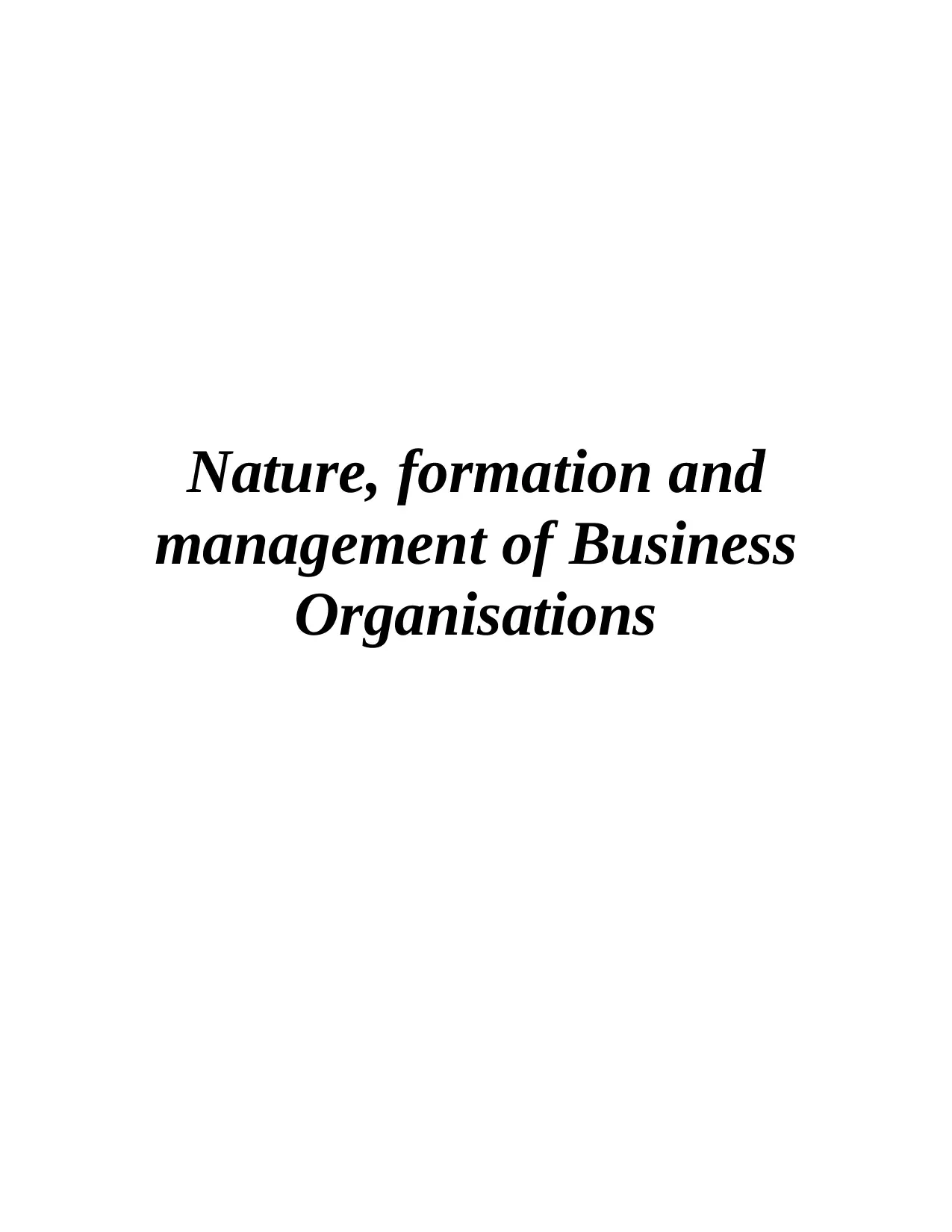
Nature, formation and
management of Business
Organisations
management of Business
Organisations
Paraphrase This Document
Need a fresh take? Get an instant paraphrase of this document with our AI Paraphraser
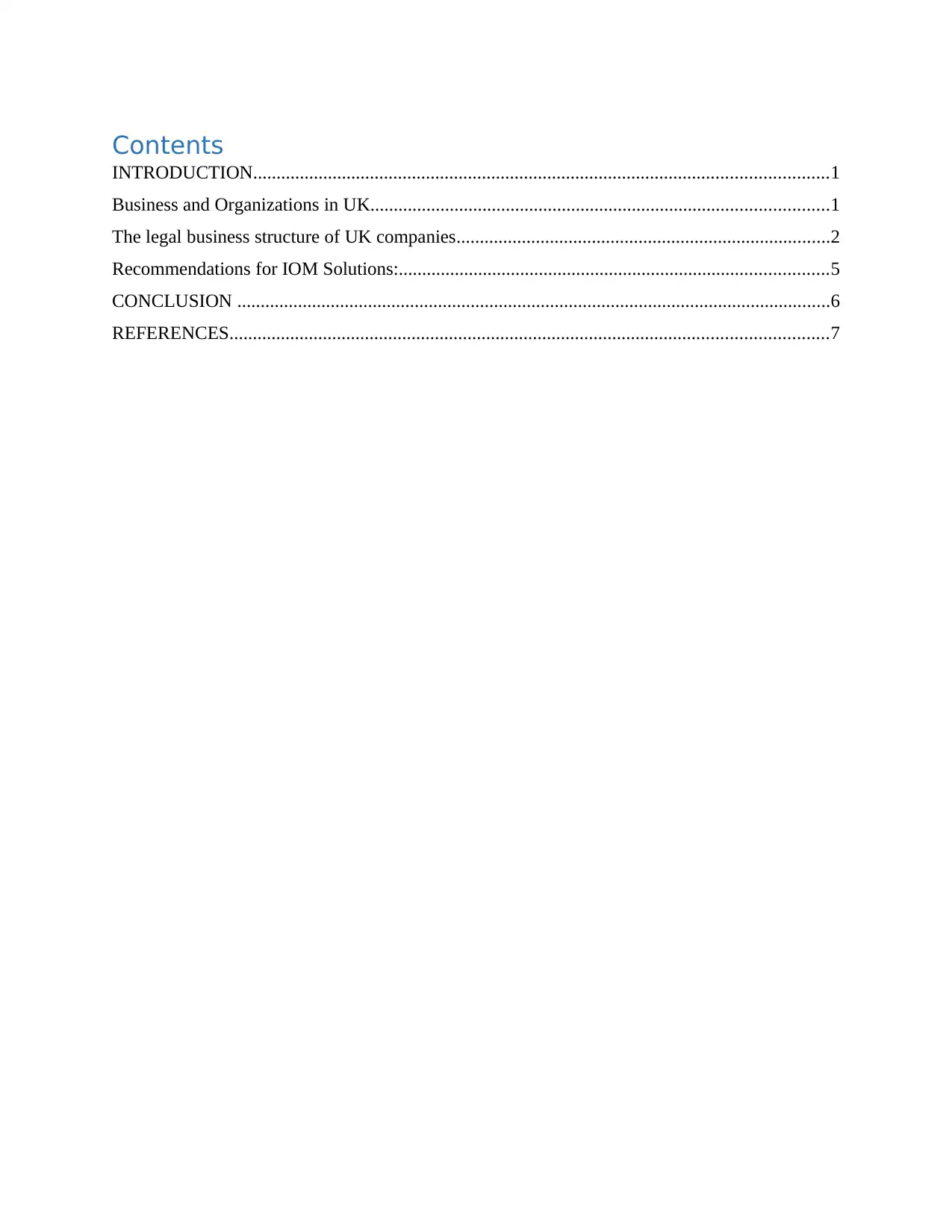
Contents
INTRODUCTION...........................................................................................................................1
Business and Organizations in UK..................................................................................................1
The legal business structure of UK companies................................................................................2
Recommendations for IOM Solutions:............................................................................................5
CONCLUSION ...............................................................................................................................6
REFERENCES................................................................................................................................7
INTRODUCTION...........................................................................................................................1
Business and Organizations in UK..................................................................................................1
The legal business structure of UK companies................................................................................2
Recommendations for IOM Solutions:............................................................................................5
CONCLUSION ...............................................................................................................................6
REFERENCES................................................................................................................................7
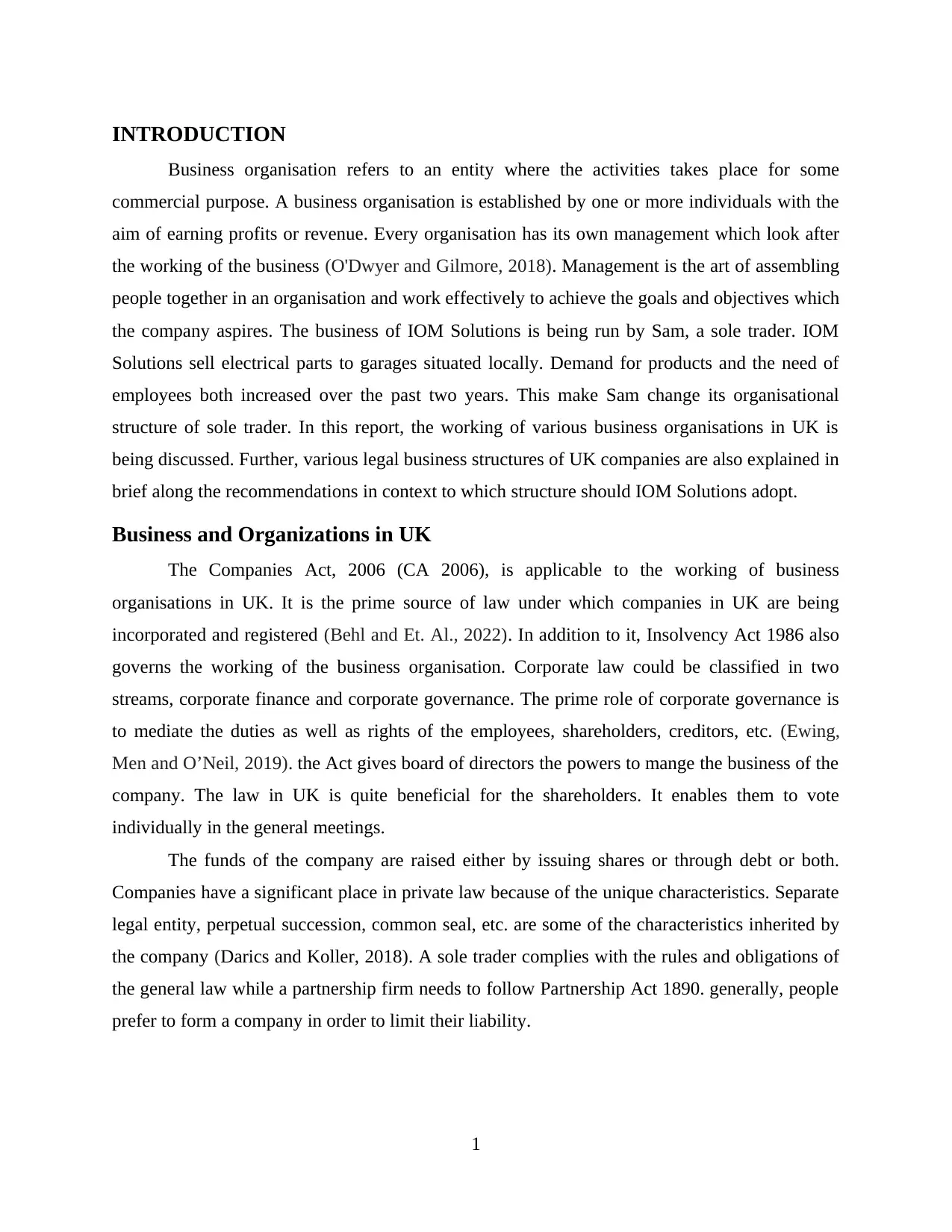
INTRODUCTION
Business organisation refers to an entity where the activities takes place for some
commercial purpose. A business organisation is established by one or more individuals with the
aim of earning profits or revenue. Every organisation has its own management which look after
the working of the business (O'Dwyer and Gilmore, 2018). Management is the art of assembling
people together in an organisation and work effectively to achieve the goals and objectives which
the company aspires. The business of IOM Solutions is being run by Sam, a sole trader. IOM
Solutions sell electrical parts to garages situated locally. Demand for products and the need of
employees both increased over the past two years. This make Sam change its organisational
structure of sole trader. In this report, the working of various business organisations in UK is
being discussed. Further, various legal business structures of UK companies are also explained in
brief along the recommendations in context to which structure should IOM Solutions adopt.
Business and Organizations in UK
The Companies Act, 2006 (CA 2006), is applicable to the working of business
organisations in UK. It is the prime source of law under which companies in UK are being
incorporated and registered (Behl and Et. Al., 2022). In addition to it, Insolvency Act 1986 also
governs the working of the business organisation. Corporate law could be classified in two
streams, corporate finance and corporate governance. The prime role of corporate governance is
to mediate the duties as well as rights of the employees, shareholders, creditors, etc. (Ewing,
Men and O’Neil, 2019). the Act gives board of directors the powers to mange the business of the
company. The law in UK is quite beneficial for the shareholders. It enables them to vote
individually in the general meetings.
The funds of the company are raised either by issuing shares or through debt or both.
Companies have a significant place in private law because of the unique characteristics. Separate
legal entity, perpetual succession, common seal, etc. are some of the characteristics inherited by
the company (Darics and Koller, 2018). A sole trader complies with the rules and obligations of
the general law while a partnership firm needs to follow Partnership Act 1890. generally, people
prefer to form a company in order to limit their liability.
1
Business organisation refers to an entity where the activities takes place for some
commercial purpose. A business organisation is established by one or more individuals with the
aim of earning profits or revenue. Every organisation has its own management which look after
the working of the business (O'Dwyer and Gilmore, 2018). Management is the art of assembling
people together in an organisation and work effectively to achieve the goals and objectives which
the company aspires. The business of IOM Solutions is being run by Sam, a sole trader. IOM
Solutions sell electrical parts to garages situated locally. Demand for products and the need of
employees both increased over the past two years. This make Sam change its organisational
structure of sole trader. In this report, the working of various business organisations in UK is
being discussed. Further, various legal business structures of UK companies are also explained in
brief along the recommendations in context to which structure should IOM Solutions adopt.
Business and Organizations in UK
The Companies Act, 2006 (CA 2006), is applicable to the working of business
organisations in UK. It is the prime source of law under which companies in UK are being
incorporated and registered (Behl and Et. Al., 2022). In addition to it, Insolvency Act 1986 also
governs the working of the business organisation. Corporate law could be classified in two
streams, corporate finance and corporate governance. The prime role of corporate governance is
to mediate the duties as well as rights of the employees, shareholders, creditors, etc. (Ewing,
Men and O’Neil, 2019). the Act gives board of directors the powers to mange the business of the
company. The law in UK is quite beneficial for the shareholders. It enables them to vote
individually in the general meetings.
The funds of the company are raised either by issuing shares or through debt or both.
Companies have a significant place in private law because of the unique characteristics. Separate
legal entity, perpetual succession, common seal, etc. are some of the characteristics inherited by
the company (Darics and Koller, 2018). A sole trader complies with the rules and obligations of
the general law while a partnership firm needs to follow Partnership Act 1890. generally, people
prefer to form a company in order to limit their liability.
1
⊘ This is a preview!⊘
Do you want full access?
Subscribe today to unlock all pages.

Trusted by 1+ million students worldwide
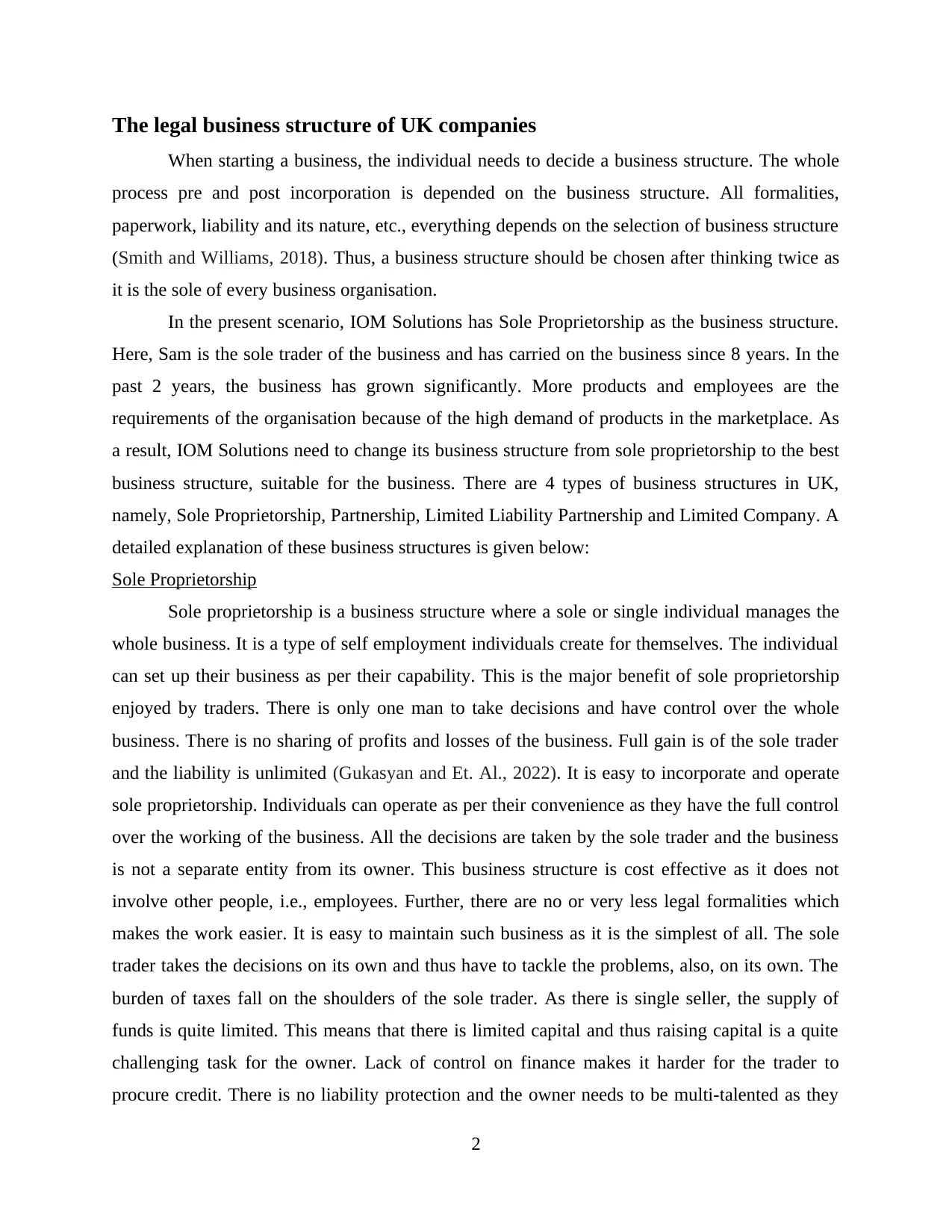
The legal business structure of UK companies
When starting a business, the individual needs to decide a business structure. The whole
process pre and post incorporation is depended on the business structure. All formalities,
paperwork, liability and its nature, etc., everything depends on the selection of business structure
(Smith and Williams, 2018). Thus, a business structure should be chosen after thinking twice as
it is the sole of every business organisation.
In the present scenario, IOM Solutions has Sole Proprietorship as the business structure.
Here, Sam is the sole trader of the business and has carried on the business since 8 years. In the
past 2 years, the business has grown significantly. More products and employees are the
requirements of the organisation because of the high demand of products in the marketplace. As
a result, IOM Solutions need to change its business structure from sole proprietorship to the best
business structure, suitable for the business. There are 4 types of business structures in UK,
namely, Sole Proprietorship, Partnership, Limited Liability Partnership and Limited Company. A
detailed explanation of these business structures is given below:
Sole Proprietorship
Sole proprietorship is a business structure where a sole or single individual manages the
whole business. It is a type of self employment individuals create for themselves. The individual
can set up their business as per their capability. This is the major benefit of sole proprietorship
enjoyed by traders. There is only one man to take decisions and have control over the whole
business. There is no sharing of profits and losses of the business. Full gain is of the sole trader
and the liability is unlimited (Gukasyan and Et. Al., 2022). It is easy to incorporate and operate
sole proprietorship. Individuals can operate as per their convenience as they have the full control
over the working of the business. All the decisions are taken by the sole trader and the business
is not a separate entity from its owner. This business structure is cost effective as it does not
involve other people, i.e., employees. Further, there are no or very less legal formalities which
makes the work easier. It is easy to maintain such business as it is the simplest of all. The sole
trader takes the decisions on its own and thus have to tackle the problems, also, on its own. The
burden of taxes fall on the shoulders of the sole trader. As there is single seller, the supply of
funds is quite limited. This means that there is limited capital and thus raising capital is a quite
challenging task for the owner. Lack of control on finance makes it harder for the trader to
procure credit. There is no liability protection and the owner needs to be multi-talented as they
2
When starting a business, the individual needs to decide a business structure. The whole
process pre and post incorporation is depended on the business structure. All formalities,
paperwork, liability and its nature, etc., everything depends on the selection of business structure
(Smith and Williams, 2018). Thus, a business structure should be chosen after thinking twice as
it is the sole of every business organisation.
In the present scenario, IOM Solutions has Sole Proprietorship as the business structure.
Here, Sam is the sole trader of the business and has carried on the business since 8 years. In the
past 2 years, the business has grown significantly. More products and employees are the
requirements of the organisation because of the high demand of products in the marketplace. As
a result, IOM Solutions need to change its business structure from sole proprietorship to the best
business structure, suitable for the business. There are 4 types of business structures in UK,
namely, Sole Proprietorship, Partnership, Limited Liability Partnership and Limited Company. A
detailed explanation of these business structures is given below:
Sole Proprietorship
Sole proprietorship is a business structure where a sole or single individual manages the
whole business. It is a type of self employment individuals create for themselves. The individual
can set up their business as per their capability. This is the major benefit of sole proprietorship
enjoyed by traders. There is only one man to take decisions and have control over the whole
business. There is no sharing of profits and losses of the business. Full gain is of the sole trader
and the liability is unlimited (Gukasyan and Et. Al., 2022). It is easy to incorporate and operate
sole proprietorship. Individuals can operate as per their convenience as they have the full control
over the working of the business. All the decisions are taken by the sole trader and the business
is not a separate entity from its owner. This business structure is cost effective as it does not
involve other people, i.e., employees. Further, there are no or very less legal formalities which
makes the work easier. It is easy to maintain such business as it is the simplest of all. The sole
trader takes the decisions on its own and thus have to tackle the problems, also, on its own. The
burden of taxes fall on the shoulders of the sole trader. As there is single seller, the supply of
funds is quite limited. This means that there is limited capital and thus raising capital is a quite
challenging task for the owner. Lack of control on finance makes it harder for the trader to
procure credit. There is no liability protection and the owner needs to be multi-talented as they
2
Paraphrase This Document
Need a fresh take? Get an instant paraphrase of this document with our AI Paraphraser
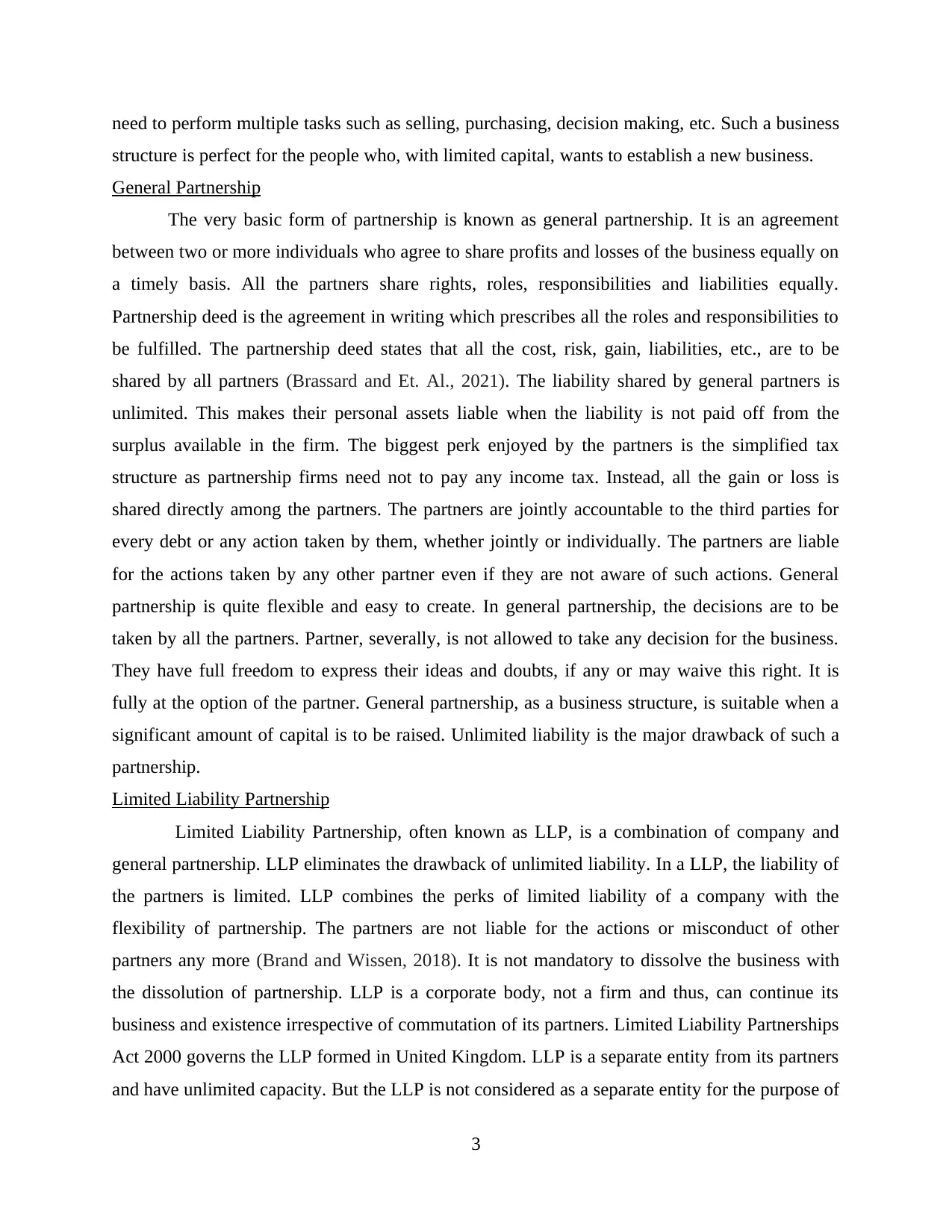
need to perform multiple tasks such as selling, purchasing, decision making, etc. Such a business
structure is perfect for the people who, with limited capital, wants to establish a new business.
General Partnership
The very basic form of partnership is known as general partnership. It is an agreement
between two or more individuals who agree to share profits and losses of the business equally on
a timely basis. All the partners share rights, roles, responsibilities and liabilities equally.
Partnership deed is the agreement in writing which prescribes all the roles and responsibilities to
be fulfilled. The partnership deed states that all the cost, risk, gain, liabilities, etc., are to be
shared by all partners (Brassard and Et. Al., 2021). The liability shared by general partners is
unlimited. This makes their personal assets liable when the liability is not paid off from the
surplus available in the firm. The biggest perk enjoyed by the partners is the simplified tax
structure as partnership firms need not to pay any income tax. Instead, all the gain or loss is
shared directly among the partners. The partners are jointly accountable to the third parties for
every debt or any action taken by them, whether jointly or individually. The partners are liable
for the actions taken by any other partner even if they are not aware of such actions. General
partnership is quite flexible and easy to create. In general partnership, the decisions are to be
taken by all the partners. Partner, severally, is not allowed to take any decision for the business.
They have full freedom to express their ideas and doubts, if any or may waive this right. It is
fully at the option of the partner. General partnership, as a business structure, is suitable when a
significant amount of capital is to be raised. Unlimited liability is the major drawback of such a
partnership.
Limited Liability Partnership
Limited Liability Partnership, often known as LLP, is a combination of company and
general partnership. LLP eliminates the drawback of unlimited liability. In a LLP, the liability of
the partners is limited. LLP combines the perks of limited liability of a company with the
flexibility of partnership. The partners are not liable for the actions or misconduct of other
partners any more (Brand and Wissen, 2018). It is not mandatory to dissolve the business with
the dissolution of partnership. LLP is a corporate body, not a firm and thus, can continue its
business and existence irrespective of commutation of its partners. Limited Liability Partnerships
Act 2000 governs the LLP formed in United Kingdom. LLP is a separate entity from its partners
and have unlimited capacity. But the LLP is not considered as a separate entity for the purpose of
3
structure is perfect for the people who, with limited capital, wants to establish a new business.
General Partnership
The very basic form of partnership is known as general partnership. It is an agreement
between two or more individuals who agree to share profits and losses of the business equally on
a timely basis. All the partners share rights, roles, responsibilities and liabilities equally.
Partnership deed is the agreement in writing which prescribes all the roles and responsibilities to
be fulfilled. The partnership deed states that all the cost, risk, gain, liabilities, etc., are to be
shared by all partners (Brassard and Et. Al., 2021). The liability shared by general partners is
unlimited. This makes their personal assets liable when the liability is not paid off from the
surplus available in the firm. The biggest perk enjoyed by the partners is the simplified tax
structure as partnership firms need not to pay any income tax. Instead, all the gain or loss is
shared directly among the partners. The partners are jointly accountable to the third parties for
every debt or any action taken by them, whether jointly or individually. The partners are liable
for the actions taken by any other partner even if they are not aware of such actions. General
partnership is quite flexible and easy to create. In general partnership, the decisions are to be
taken by all the partners. Partner, severally, is not allowed to take any decision for the business.
They have full freedom to express their ideas and doubts, if any or may waive this right. It is
fully at the option of the partner. General partnership, as a business structure, is suitable when a
significant amount of capital is to be raised. Unlimited liability is the major drawback of such a
partnership.
Limited Liability Partnership
Limited Liability Partnership, often known as LLP, is a combination of company and
general partnership. LLP eliminates the drawback of unlimited liability. In a LLP, the liability of
the partners is limited. LLP combines the perks of limited liability of a company with the
flexibility of partnership. The partners are not liable for the actions or misconduct of other
partners any more (Brand and Wissen, 2018). It is not mandatory to dissolve the business with
the dissolution of partnership. LLP is a corporate body, not a firm and thus, can continue its
business and existence irrespective of commutation of its partners. Limited Liability Partnerships
Act 2000 governs the LLP formed in United Kingdom. LLP is a separate entity from its partners
and have unlimited capacity. But the LLP is not considered as a separate entity for the purpose of
3
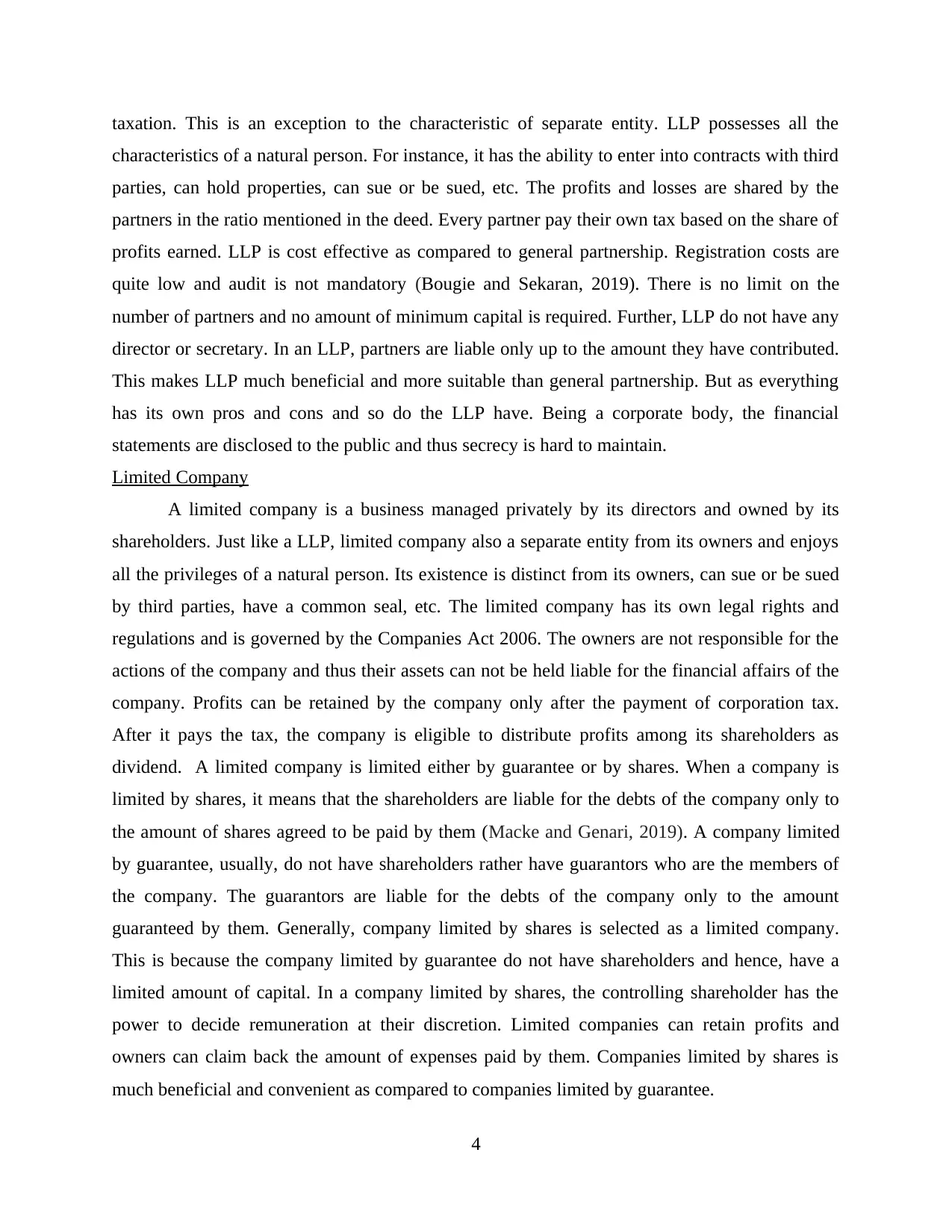
taxation. This is an exception to the characteristic of separate entity. LLP possesses all the
characteristics of a natural person. For instance, it has the ability to enter into contracts with third
parties, can hold properties, can sue or be sued, etc. The profits and losses are shared by the
partners in the ratio mentioned in the deed. Every partner pay their own tax based on the share of
profits earned. LLP is cost effective as compared to general partnership. Registration costs are
quite low and audit is not mandatory (Bougie and Sekaran, 2019). There is no limit on the
number of partners and no amount of minimum capital is required. Further, LLP do not have any
director or secretary. In an LLP, partners are liable only up to the amount they have contributed.
This makes LLP much beneficial and more suitable than general partnership. But as everything
has its own pros and cons and so do the LLP have. Being a corporate body, the financial
statements are disclosed to the public and thus secrecy is hard to maintain.
Limited Company
A limited company is a business managed privately by its directors and owned by its
shareholders. Just like a LLP, limited company also a separate entity from its owners and enjoys
all the privileges of a natural person. Its existence is distinct from its owners, can sue or be sued
by third parties, have a common seal, etc. The limited company has its own legal rights and
regulations and is governed by the Companies Act 2006. The owners are not responsible for the
actions of the company and thus their assets can not be held liable for the financial affairs of the
company. Profits can be retained by the company only after the payment of corporation tax.
After it pays the tax, the company is eligible to distribute profits among its shareholders as
dividend. A limited company is limited either by guarantee or by shares. When a company is
limited by shares, it means that the shareholders are liable for the debts of the company only to
the amount of shares agreed to be paid by them (Macke and Genari, 2019). A company limited
by guarantee, usually, do not have shareholders rather have guarantors who are the members of
the company. The guarantors are liable for the debts of the company only to the amount
guaranteed by them. Generally, company limited by shares is selected as a limited company.
This is because the company limited by guarantee do not have shareholders and hence, have a
limited amount of capital. In a company limited by shares, the controlling shareholder has the
power to decide remuneration at their discretion. Limited companies can retain profits and
owners can claim back the amount of expenses paid by them. Companies limited by shares is
much beneficial and convenient as compared to companies limited by guarantee.
4
characteristics of a natural person. For instance, it has the ability to enter into contracts with third
parties, can hold properties, can sue or be sued, etc. The profits and losses are shared by the
partners in the ratio mentioned in the deed. Every partner pay their own tax based on the share of
profits earned. LLP is cost effective as compared to general partnership. Registration costs are
quite low and audit is not mandatory (Bougie and Sekaran, 2019). There is no limit on the
number of partners and no amount of minimum capital is required. Further, LLP do not have any
director or secretary. In an LLP, partners are liable only up to the amount they have contributed.
This makes LLP much beneficial and more suitable than general partnership. But as everything
has its own pros and cons and so do the LLP have. Being a corporate body, the financial
statements are disclosed to the public and thus secrecy is hard to maintain.
Limited Company
A limited company is a business managed privately by its directors and owned by its
shareholders. Just like a LLP, limited company also a separate entity from its owners and enjoys
all the privileges of a natural person. Its existence is distinct from its owners, can sue or be sued
by third parties, have a common seal, etc. The limited company has its own legal rights and
regulations and is governed by the Companies Act 2006. The owners are not responsible for the
actions of the company and thus their assets can not be held liable for the financial affairs of the
company. Profits can be retained by the company only after the payment of corporation tax.
After it pays the tax, the company is eligible to distribute profits among its shareholders as
dividend. A limited company is limited either by guarantee or by shares. When a company is
limited by shares, it means that the shareholders are liable for the debts of the company only to
the amount of shares agreed to be paid by them (Macke and Genari, 2019). A company limited
by guarantee, usually, do not have shareholders rather have guarantors who are the members of
the company. The guarantors are liable for the debts of the company only to the amount
guaranteed by them. Generally, company limited by shares is selected as a limited company.
This is because the company limited by guarantee do not have shareholders and hence, have a
limited amount of capital. In a company limited by shares, the controlling shareholder has the
power to decide remuneration at their discretion. Limited companies can retain profits and
owners can claim back the amount of expenses paid by them. Companies limited by shares is
much beneficial and convenient as compared to companies limited by guarantee.
4
⊘ This is a preview!⊘
Do you want full access?
Subscribe today to unlock all pages.

Trusted by 1+ million students worldwide
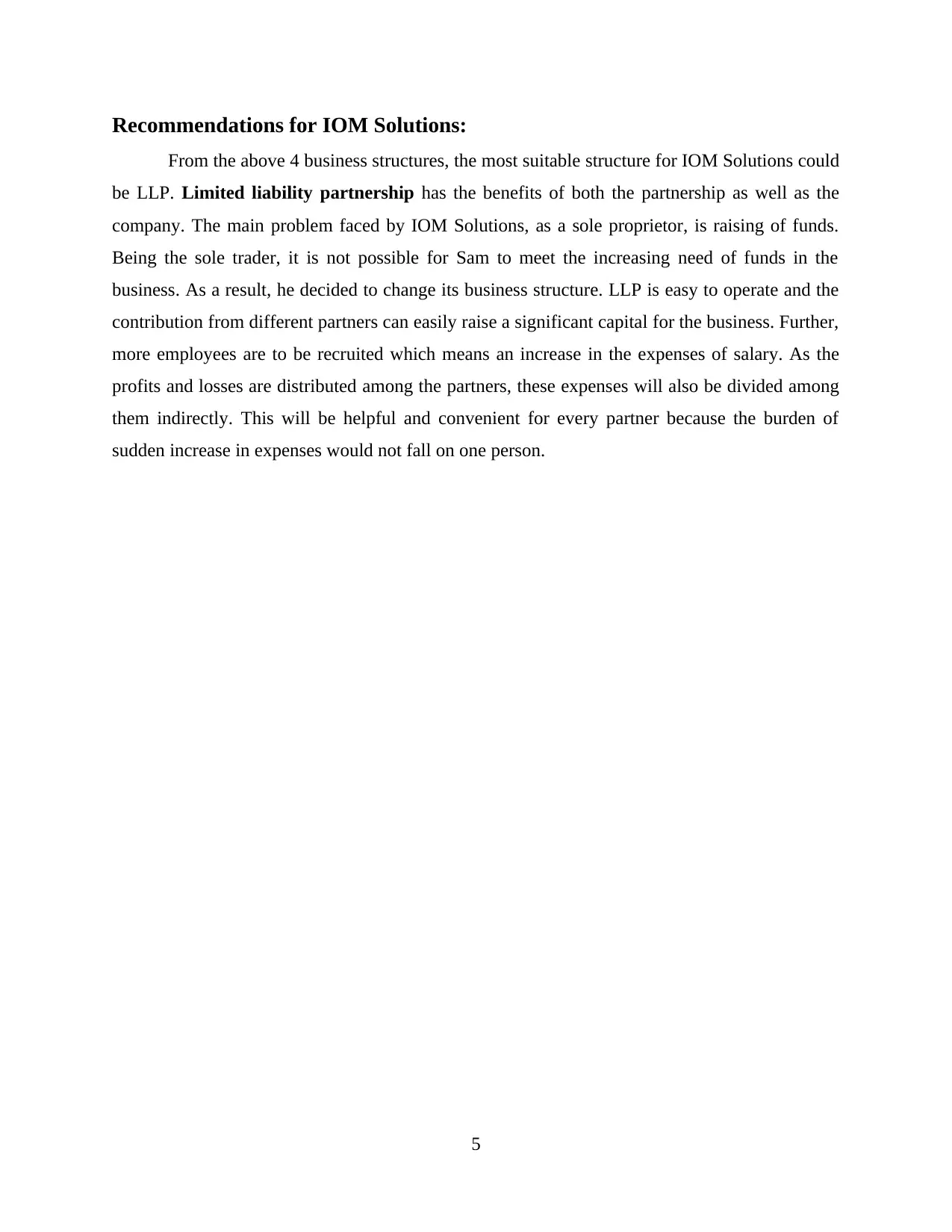
Recommendations for IOM Solutions:
From the above 4 business structures, the most suitable structure for IOM Solutions could
be LLP. Limited liability partnership has the benefits of both the partnership as well as the
company. The main problem faced by IOM Solutions, as a sole proprietor, is raising of funds.
Being the sole trader, it is not possible for Sam to meet the increasing need of funds in the
business. As a result, he decided to change its business structure. LLP is easy to operate and the
contribution from different partners can easily raise a significant capital for the business. Further,
more employees are to be recruited which means an increase in the expenses of salary. As the
profits and losses are distributed among the partners, these expenses will also be divided among
them indirectly. This will be helpful and convenient for every partner because the burden of
sudden increase in expenses would not fall on one person.
5
From the above 4 business structures, the most suitable structure for IOM Solutions could
be LLP. Limited liability partnership has the benefits of both the partnership as well as the
company. The main problem faced by IOM Solutions, as a sole proprietor, is raising of funds.
Being the sole trader, it is not possible for Sam to meet the increasing need of funds in the
business. As a result, he decided to change its business structure. LLP is easy to operate and the
contribution from different partners can easily raise a significant capital for the business. Further,
more employees are to be recruited which means an increase in the expenses of salary. As the
profits and losses are distributed among the partners, these expenses will also be divided among
them indirectly. This will be helpful and convenient for every partner because the burden of
sudden increase in expenses would not fall on one person.
5
Paraphrase This Document
Need a fresh take? Get an instant paraphrase of this document with our AI Paraphraser
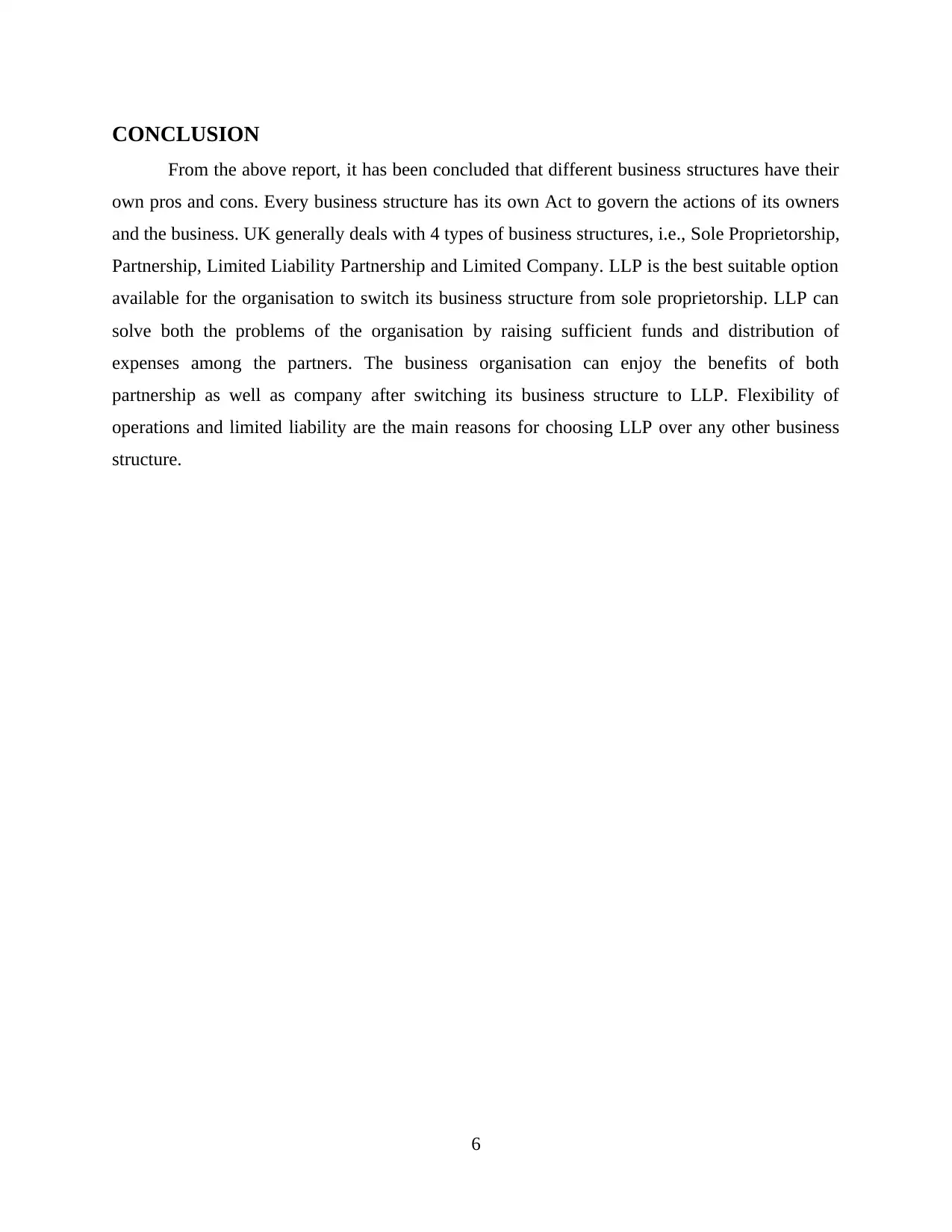
CONCLUSION
From the above report, it has been concluded that different business structures have their
own pros and cons. Every business structure has its own Act to govern the actions of its owners
and the business. UK generally deals with 4 types of business structures, i.e., Sole Proprietorship,
Partnership, Limited Liability Partnership and Limited Company. LLP is the best suitable option
available for the organisation to switch its business structure from sole proprietorship. LLP can
solve both the problems of the organisation by raising sufficient funds and distribution of
expenses among the partners. The business organisation can enjoy the benefits of both
partnership as well as company after switching its business structure to LLP. Flexibility of
operations and limited liability are the main reasons for choosing LLP over any other business
structure.
6
From the above report, it has been concluded that different business structures have their
own pros and cons. Every business structure has its own Act to govern the actions of its owners
and the business. UK generally deals with 4 types of business structures, i.e., Sole Proprietorship,
Partnership, Limited Liability Partnership and Limited Company. LLP is the best suitable option
available for the organisation to switch its business structure from sole proprietorship. LLP can
solve both the problems of the organisation by raising sufficient funds and distribution of
expenses among the partners. The business organisation can enjoy the benefits of both
partnership as well as company after switching its business structure to LLP. Flexibility of
operations and limited liability are the main reasons for choosing LLP over any other business
structure.
6
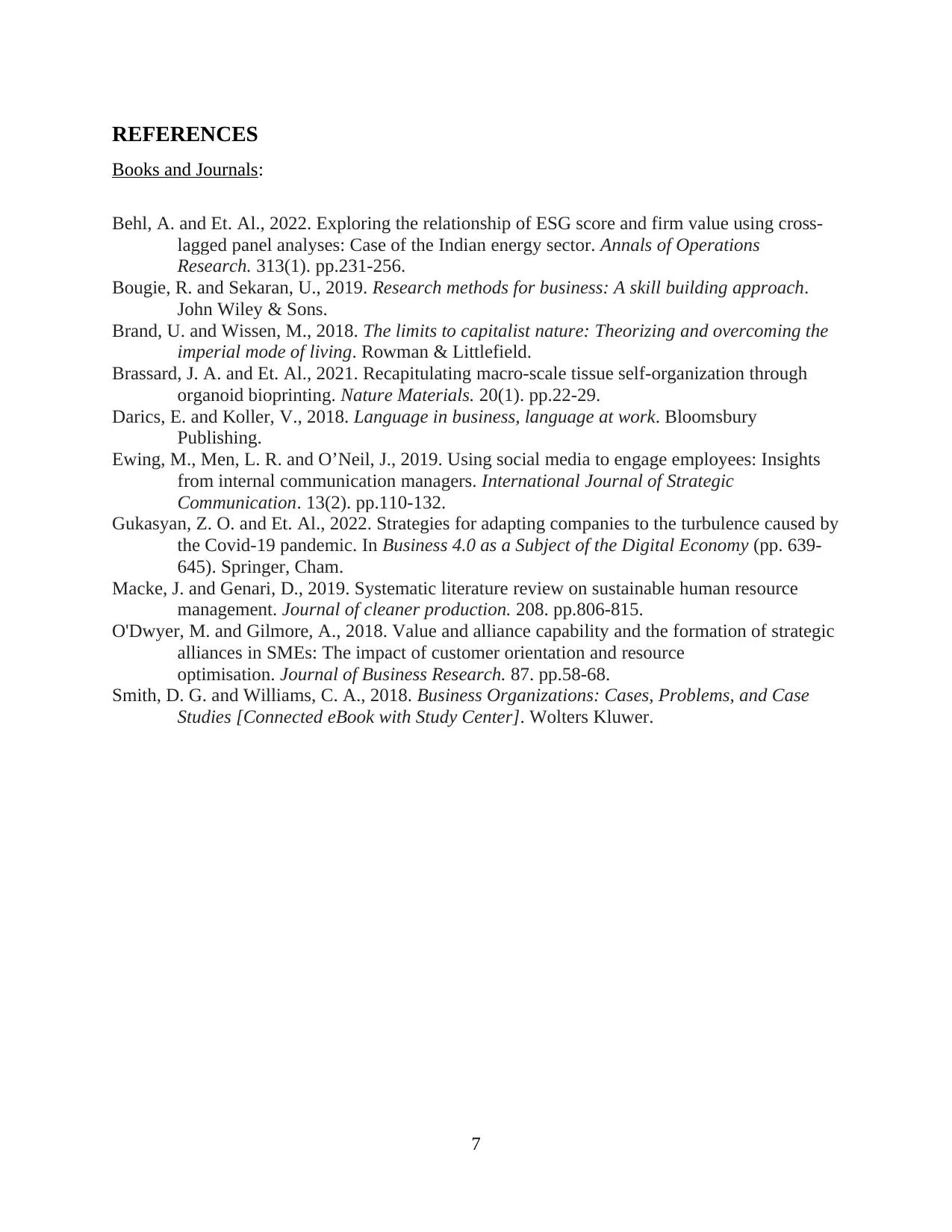
REFERENCES
Books and Journals:
Behl, A. and Et. Al., 2022. Exploring the relationship of ESG score and firm value using cross-
lagged panel analyses: Case of the Indian energy sector. Annals of Operations
Research. 313(1). pp.231-256.
Bougie, R. and Sekaran, U., 2019. Research methods for business: A skill building approach.
John Wiley & Sons.
Brand, U. and Wissen, M., 2018. The limits to capitalist nature: Theorizing and overcoming the
imperial mode of living. Rowman & Littlefield.
Brassard, J. A. and Et. Al., 2021. Recapitulating macro-scale tissue self-organization through
organoid bioprinting. Nature Materials. 20(1). pp.22-29.
Darics, E. and Koller, V., 2018. Language in business, language at work. Bloomsbury
Publishing.
Ewing, M., Men, L. R. and O’Neil, J., 2019. Using social media to engage employees: Insights
from internal communication managers. International Journal of Strategic
Communication. 13(2). pp.110-132.
Gukasyan, Z. O. and Et. Al., 2022. Strategies for adapting companies to the turbulence caused by
the Covid-19 pandemic. In Business 4.0 as a Subject of the Digital Economy (pp. 639-
645). Springer, Cham.
Macke, J. and Genari, D., 2019. Systematic literature review on sustainable human resource
management. Journal of cleaner production. 208. pp.806-815.
O'Dwyer, M. and Gilmore, A., 2018. Value and alliance capability and the formation of strategic
alliances in SMEs: The impact of customer orientation and resource
optimisation. Journal of Business Research. 87. pp.58-68.
Smith, D. G. and Williams, C. A., 2018. Business Organizations: Cases, Problems, and Case
Studies [Connected eBook with Study Center]. Wolters Kluwer.
7
Books and Journals:
Behl, A. and Et. Al., 2022. Exploring the relationship of ESG score and firm value using cross-
lagged panel analyses: Case of the Indian energy sector. Annals of Operations
Research. 313(1). pp.231-256.
Bougie, R. and Sekaran, U., 2019. Research methods for business: A skill building approach.
John Wiley & Sons.
Brand, U. and Wissen, M., 2018. The limits to capitalist nature: Theorizing and overcoming the
imperial mode of living. Rowman & Littlefield.
Brassard, J. A. and Et. Al., 2021. Recapitulating macro-scale tissue self-organization through
organoid bioprinting. Nature Materials. 20(1). pp.22-29.
Darics, E. and Koller, V., 2018. Language in business, language at work. Bloomsbury
Publishing.
Ewing, M., Men, L. R. and O’Neil, J., 2019. Using social media to engage employees: Insights
from internal communication managers. International Journal of Strategic
Communication. 13(2). pp.110-132.
Gukasyan, Z. O. and Et. Al., 2022. Strategies for adapting companies to the turbulence caused by
the Covid-19 pandemic. In Business 4.0 as a Subject of the Digital Economy (pp. 639-
645). Springer, Cham.
Macke, J. and Genari, D., 2019. Systematic literature review on sustainable human resource
management. Journal of cleaner production. 208. pp.806-815.
O'Dwyer, M. and Gilmore, A., 2018. Value and alliance capability and the formation of strategic
alliances in SMEs: The impact of customer orientation and resource
optimisation. Journal of Business Research. 87. pp.58-68.
Smith, D. G. and Williams, C. A., 2018. Business Organizations: Cases, Problems, and Case
Studies [Connected eBook with Study Center]. Wolters Kluwer.
7
⊘ This is a preview!⊘
Do you want full access?
Subscribe today to unlock all pages.

Trusted by 1+ million students worldwide
1 out of 9
Related Documents
Your All-in-One AI-Powered Toolkit for Academic Success.
+13062052269
info@desklib.com
Available 24*7 on WhatsApp / Email
![[object Object]](/_next/static/media/star-bottom.7253800d.svg)
Unlock your academic potential
Copyright © 2020–2025 A2Z Services. All Rights Reserved. Developed and managed by ZUCOL.


